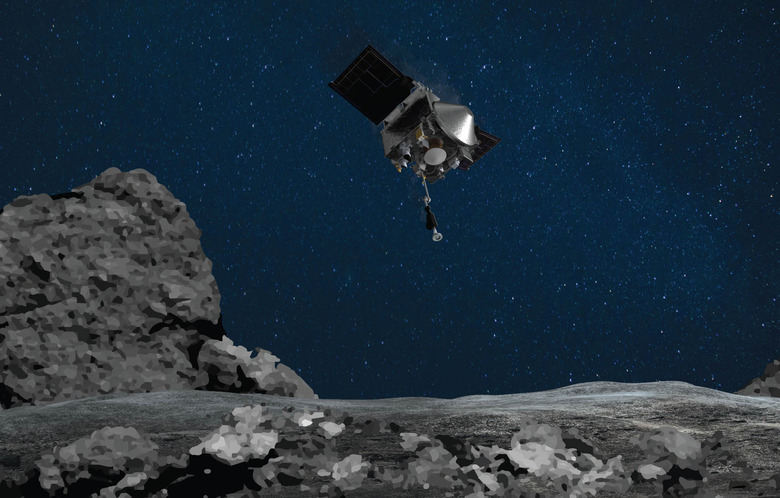NASA's Asteroid Probe Grabbed So Much Material It Was 'Overflowing'
- NASA's OSIRIS-REx mission is going even better than scientists thought, and the asteroid probe collected so much material that its handlers sped up the timeline to ensure they bring as much back to Earth as possible.
- The sampling arm was literally "overflowing" with material from the asteroid, NASA says.
- Eventually, the spacecraft will head back to Earth where it will drop off the sample so that scientists can study it first-hand.
It's been a very big month for NASA's asteroid-hunting ambitions. The space agency's OSIRIS-REx spacecraft successfully performed its delicate "Touch and Go" or TAG maneuver by touching down on the space rock known as Bennu for a few seconds before returning to a safe orbit. During those brief moments, the spacecraft kicked up a bunch of asteroid surface material and attempted to capture it.
Days later, it finally became clear that the capture arm did indeed grab enough material for it to be saved for the journey home. However, saving the material isn't just a matter of stuffing it in the spacecraft's pocket. The stowing process takes time, but the good news is that the stowing procedure was indeed completed successfully.
The spacecraft's ultimate goal is to bring material from the surface of the asteroid back to Earth so that scientists can study it first-hand. The trip back to Earth hasn't yet begun, but the hardest parts seem to be in the rearview. Probe survived its close encounter with the space rock, grabbed a sample, and it's now stowed safely away.
In fact, the sample-snatching maneuver worked so well that the team sped up the timeline for stowing the sample:
The stowage process, originally scheduled to begin in early November, was expedited after sample collection when the mission team received images that showed the spacecraft's collector head overflowing with material. The images indicated that the spacecraft collected well over 2 ounces (60 grams) of Bennu's surface material, and that some of these particles appeared to be slowly escaping from the head. A mylar flap designed to keep the sample inside the head appeared to be wedged open by some larger rocks. Now that the head is secure inside the SRC, pieces of the sample will no longer be lost.
"This achievement by OSIRIS-REx on behalf of NASA and the world has lifted our vision to the higher things we can achieve together, as teams and nations," NASA Administrator Jim Bridenstine said in a statement. "Together a team comprising industry, academia and international partners, and a talented and diverse team of NASA employees with all types of expertise, has put us on course to vastly increase our collection on Earth of samples from space. Samples like this are going to transform what we know about our universe and ourselves, which is at the base of all NASA's endeavors."
The spacecraft's return to Earth will take many months, but you can bet that scientists will be mighty excited when it finally arrives.
